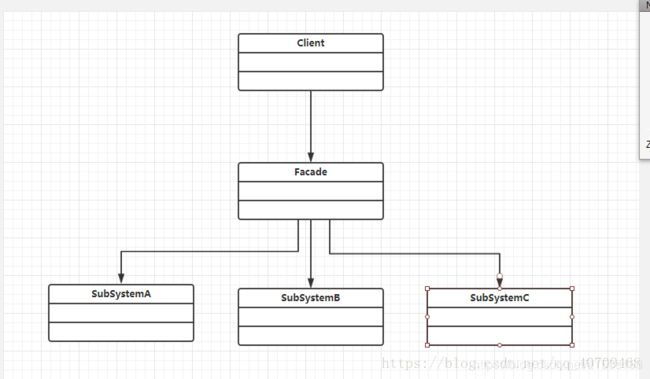- 今天写一篇新手向,如何快速写出SpringMVC架构
小巫程序Demo日记
Spring深层了解架构springbootjava
小巫程序Demo日记:如何快速掌握MVC架构思想一、MVC是什么?在学习SpringMVC之前,我们首先需要弄明白MVC是什么。MVC是一种设计模式,全称是Model-View-Controller(模型-视图-控制器),它将应用程序分成三个主要部分,彼此分工明确:Model(模型)作用:负责管理数据和业务逻辑。职责:存储数据(比如数据库中的用户信息)、处理数据的规则(比如验证输入是否合法)、以及
- 解锁状态模式:Java 编程中的行为魔法
编程巫师
设计模式状态模式java开发语言
系列文章目录后续补充~~~文章目录一、状态模式:概念与原理二、状态模式的深度剖析(一)模式定义与核心思想(二)模式结构与角色三、状态模式的实际应用场景(一)电商系统中的订单状态管理(二)游戏开发中的角色状态管理(三)工作流系统中的任务状态管理四、Java代码示例展示(一)电商订单状态管理代码实现(二)测试代码与运行结果五、状态模式的优缺点分析(一)优点(二)缺点六、状态模式与其他设计模式的协作(一
- 创建型模式 - 工厂模式 (Factory pattern)
_真相只有一个
Java设计模式设计模式java
创建型模式-工厂模式(Factorypattern)工厂模式是一种创建型设计模式,它提供了一种创建对象的方式,将对象的创建和使用分离,使得代码更具可维护性和可扩展性。常见的工厂模式有简单工厂模式、工厂方法模式和抽象工厂模式简单工厂违背开闭原则,简单工厂模式并不属于GoF23种设计模式,但它是思想是工厂模式的基础。需求描述在一个图形绘制系统里,需要根据用户输入的形状类型(圆形、矩形、三角形)来创建相
- 结构型模式 - 享元模式 (Flyweight Pattern)
_真相只有一个
Java设计模式享元模式设计模式
结构型模式-享元模式(FlyweightPattern)享元模式是一种结构型设计模式,它通过共享对象来减少内存使用和提高性能,尤其适用于存在大量细粒度对象且这些对象有部分状态可共享的场景。举个经典案例,下围棋,黑子和白子可以用享元,每一颗棋子除了放置的位置之外,只有颜色区分.importjava.util.ArrayList;importjava.util.HashMap;importjava.u
- 创建型模式 - 单例模式 (Singleten Pattern)
_真相只有一个
Java设计模式单例模式java设计模式
创建型模式-单例模式(SingletenPattern)单例模式是一种创建型设计模式,它确保一个类只有一个实例,并提供一个全局访问点来获取这个实例。一共还能细分为以下几种:饿汉式单例(EagerInitialization)懒汉式单例(LazyInitialization)双重检查锁(Double-CheckedLocking)静态内部类(StaticInnerClass)枚举单例(EnumSin
- java23种设计模式-享元模式
千里码!
设计模式后端技术#Java设计模式享元模式java
享元模式(FlyweightPattern)学习笔记1.模式定义结构型设计模式,通过共享技术实现大量细粒度对象的复用,有效减少内存占用并提高性能。核心思想:分离内部状态(可共享)与外部状态(不可共享)2.适用场景✅系统中存在大量相似对象✅对象的大部分状态可以外部化✅需要缓存池或对象池的应用✅需要减少内存占用和提高性能的场景3.模式结构createsrequestsFlyweightFactory-
- 23设计模式详解「全23种」
小北编程
Java精选设计模式
✍️作者简介:小北编程(专注于HarmonyOS、Android、Java、Web、TCP/IP等技术方向)博客主页:开源中国、稀土掘金、51cto博客、博客园、知乎、简书、慕课网、CSDN如果文章对您有一定的帮助请关注✨、点赞、收藏、评论。如需转载请参考【转载须知】文章目录设计模式介绍一、什么是设计模式二、设计模式表述三、设计模式分类1.创建型模式(CreationalPatterns):2.结
- 设计模式教程:模板方法模式(Template Method Pattern)
扣丁梦想家
设计模式教程设计模式模板方法模式java
一、概述模板方法模式(TemplateMethodPattern)是一种行为型设计模式,旨在定义一个操作中的算法骨架,而将一些步骤的具体实现延迟到子类中。通过模板方法模式,父类可以不改变算法结构的情况下,让子类重新定义某些步骤的实现,从而使得不同的子类可以有不同的行为。模板方法模式适用于那些具有相同的整体流程但又希望子类可以在某些步骤上有所不同的场景。二、模板方法模式的结构模板方法模式主要包括以下
- Java 设计模式面试题
code36
Java面试题设计模式java面试
说一下开发中需要遵守的设计原则?设计模式中主要有六大设计原则,简称为SOLID,是由于各个原则的首字母简称合并的来(两个L算一个,solid稳定的),六大设计原则分别如下:1、单一职责原则单一职责原则的定义描述非常简单,也不难理解。一个类只负责完成一个职责或者功能。也就是说在类的设计中我们不要设计大而全的类,而是要设计粒度小、功能单一的类。比如我们设计一个类里面既包含了用户的一些操作,又包含了支付
- 导读:生活中的设计模式——启程之前,请不要错过我
陌尘(MoChen)
精品课设计模式Python榜单
为什么叫设计模式什么是设计模式设计模式与生活有什么联系为什么要学设计模式如何进行学习为什么选择Python弥补市场空缺大势所趋,Python已然成风简单的Python基础Python的特点基本语法常用容器List(列表)Tuple(元组)Dictionary(字典)类的定义Demo让你顿悟重要说明两年前CSDN出了一个产品叫ink,旨在提供一个高质量的写作环境,那时就有写设计模式这一系列的想法了,
- 设计模式1---简单工厂模式、工厂方法模式、抽象工厂模式
Sunと
c++专栏设计模式简单工厂模式工厂方法模式c++
三种工厂模式-创建对象的灵活工具在23种设计模式中,总体来说设计模式分为三大类:创建型模式结构型模式行为型模式其中,创建型模式,共五种:工厂方法模式、抽象工厂模式、单例模式、建造者模式、原型模式。本文将介绍工厂方法模式、抽象工厂模式2种,其中,工厂方法模式一般可以分为简单工厂模式及工厂模式。简单工厂模式概念简单工厂模式是一种创建型设计模式,旨在引入一个工厂类来创建不同类型的对象,无需直接实例化这些
- 设计模式 工厂模式 工厂方法模式 抽象工厂模式
她说喜欢是装的.
web后端开发web开发基础设计模式工厂方法模式抽象工厂模式
目录工厂模式的优点工厂模式的类型实例简单工厂模式工厂方法模式抽象工厂模式常见的应用场景注意事项工厂方法设计模式Java代码实现代码解析输出结果解析总结好,我需要解释Java中的工厂模式。首先,工厂模式是一种创建型设计模式,主要用于对象的创建。它通过工厂类来封装创建过程,这样可以减少耦合度。那工厂模式有什么优点呢?嗯,首先是解耦了创建和使用,这样客户端不需要知道具体怎么创建对象,只需要调用工厂方法。
- 实战讲解,原来是用 SpringBoot 实现策略模式可以这么简单
java小浩
javaspringboot开发语言
一、介绍一说起策略设计模式,相比大家都不陌生,在实际的业务开发中,合理的使用设计模式来编程,可以让代码阅读起来层次感更强,同时扩展性也会得到提升!最近看同事的代码时候,学到了一个小技巧,在某些场景下合理的使用策略模式还是非常有用的,在此分享一下给大家。二、代码实践在介绍SpringBoot中如何实现策略设计模式之前,我们先简单的回顾一下策略模式的设计思路。以编写一个简单的程序计算器,代码如下!首先
- java23种设计模式-装饰器模式
千里码!
设计模式后端技术#Java设计模式装饰器模式
装饰者模式(DecoratorPattern)学习笔记1.模式定义结构型设计模式,动态地为对象添加额外的职责。通过组合而非继承的方式扩展功能,提供比继承更灵活的替代方案。2.适用场景✅需要动态/透明地给对象添加功能✅需要撤销附加功能时✅无法通过继承扩展功能(final类)✅需要组合多个可选功能✅避免"子类爆炸"问题3.模式结构«interface»Component+operation()Conc
- java23种设计模式-观察者模式
千里码!
设计模式后端技术#Java设计模式观察者模式
观察者模式(ObserverPattern)学习笔记编程相关书籍分享:https://blog.csdn.net/weixin_47763579/article/details/145855793DeepSeek使用技巧pdf资料分享:https://blog.csdn.net/weixin_47763579/article/details/1458840391.模式定义行为型设计模式,定义对象间
- 设计模式-(装饰器,适配器,观察者,外观)
*^O^*—*^O^*
设计模式
装饰器模式概念:它允许在不改变对象自身的情况下,动态地给对象添加额外的功能。通过使用装饰器模式,可以在运行时对对象进行扩展,而不需要创建大量的子类应用:当你希望在不修改原有类的情况下,给对象添加新的行为或状态时当你需要在运行时组合多个功能,而不是在编译时就决定好时当你有很多类需要组合不同的功能时,使用装饰器可以避免创建大量的子类代码://抽象组件abstractclassBeverage{Stri
- 【Java设计模式】Java设计模式之(十五)策略模式(Strategy Pattern)
No8g攻城狮
Java设计模式设计模式java开发语言
本文目录一、策略模式介绍1.1含义1.2适用场景1.3主要解决1.4应用实例1.5优缺点二、策略模式实现2.1类图2.2代码实现第一个案例:策略模式代码实现第二个案例:策略模式代码实现2.3角色分析三、源码分析这种类型的设计模式属于行为型模式。一、策略模式介绍1.1含义在策略模式(StrategyPattern)中,一个类的行为或其算法可以在运行时更改。这种类型的设计模式属于行为型模式。在策略模式
- Java设计模式:中介者模式详解与最佳实践
范范0825
java设计模式中介者模式
Java设计模式:中介者模式详解与最佳实践1.引言在软件开发过程中,特别是复杂系统的构建中,模块间的交互往往成为影响代码质量的重要因素。当模块之间耦合度过高时,系统的维护、扩展和理解成本都会显著增加。为了降低模块之间的耦合度,保持系统的灵活性和可维护性,我们可以使用设计模式中的中介者模式(MediatorPattern)。本篇文章将详细介绍中介者模式的概念、优点及其在Java中的应用,并通过实例代
- springboot中工厂+策略模式实际应用
BraveTT
策略模式java开发语言
之前只是在各种博客和书籍上看到设计模式使用的理论知识,今天在项目中,正好遇到了这种需求,于是想着用这俩种模式实战一下,没想到成功了,记录一下,也欢迎各位大兄弟们继续给出好的建议。需求:有一个列表的数据,数据里有状态一栏,但是不同角色看到的状态值不一样。原先处理方法:对于各种新手小伙伴来说,是不是要各种if判断角色code,然后在不同的if里,去修改状态的文本值?类似于这样:if(roleCodeC
- (十)趣学设计模式 之 外观模式!
码熔burning
设计模式设计模式外观模式java
目录一、啥是外观模式?二、为什么要用外观模式?三、外观模式的实现方式四、外观模式的优缺点五、外观模式的应用场景六、总结我的其他文章也讲解的比较有趣,如果喜欢博主的讲解方式,可以多多支持一下,感谢!了解桥接模式请看:(九)趣学设计模式之桥接模式!这篇文章带你详细认识一下设计模式中的外观模式一、啥是外观模式?想象一下,你想做一道复杂的菜(比如:佛跳墙),你需要准备各种食材、处理食材、烹饪食材等等一系列
- Java常见设计模式(上):创建型模式
啥都不懂的小小白
Java知识集锦java设计模式开发语言
设计模式概述设计模式是从大量的实践中总结和理论化之后优选的代码结构、编程风格、以及问题解决思路。它们如同经典棋谱,不同的棋局不同棋局对应不同“套路”,帮助我们高效应对各种编程挑战。设计原则是一些通用的设计指导方针,它们提供了如何设计一个优秀的软件系统的基本思想和规则。指导着设计者如何组织代码以实现高内聚、低耦合、易扩展和易维护的软件系统。设计模式则是在特定情况下解决常见问题的经验性解决方案,它们提
- 策略模式结合springboot开发
别告诉我有BUG
设计模式java设计模式
策略模式介绍策略模式是什么?策略模式是依赖接口多实现的一种设计模式,通一接口的方法通过不同的实现方式呈现接口的多态。策略模式中上下文对象,上下文对象封装了接口的具体实现,与一些逻辑,是提供服务与实际的服务底层逻辑相互分离。结合springboot实现策略模式1、创建公共接口类2、构建类去实现这个公共接口,实现类可以有多个3、构建上下文对象类,去封装实现的逻辑(可以通过注入的方式创建接口实现类)4、
- 利用springboot初始化机制三种实现策略模式的应用
π大星的日常
java策略模式springbootjava
面试时总被问,spring中使用了哪些设计模式,你在实际开发中又使用哪些设计模式。给他手指一个方向跟他说,这就是一个模式:goout!。这就是一种模式:策略模式,一个接口的多个实现方式(算法)。本文梳理了使用springboot实现的三种实现策略模式的应用我们知道,springboot应用初始化的过程是通过事件机制进行的。主要是通过EventPublishingRunListener在不同的初始化
- Spring Boot整合策略模式:概念、使用场景、优缺点及企业级Java
程序才子
javaspringboot策略模式Java
策略模式是一种行为型设计模式,它允许在运行时选择算法的行为。SpringBoot是一个流行的Java开发框架,提供了简化的配置和快速开发的能力。在本文中,我们将探讨如何在SpringBoot应用程序中使用策略模式,讨论其使用场景、优缺点,并介绍如何在企业级Java应用程序中应用该模式。1.策略模式概念策略模式通过定义一系列算法,并将其封装在可互换的策略对象中,使得这些算法可以相互替换。它将算法的选
- 【HeadFirst系列之HeadFirst设计模式】第13天之代理模式:控制对象访问的利器!
工一木子
HeadFirst系列HeadFirst设计模式笔记设计模式代理模式
代理模式:控制对象访问的利器!大家好!今天我们来聊聊设计模式中的代理模式(ProxyPattern)。如果你曾经需要控制对某个对象的访问,或者在访问对象时添加额外的逻辑(如权限检查、日志记录等),那么代理模式就是你的救星!本文基于《HeadFirst设计模式》的代理模式章节,通过生动的故事和Java代码示例,带你轻松掌握代理模式的精髓。我们还会探讨代理模式在JDK和Spring等框架中的应用,让你
- Java集合设计模式面试题
夜游猿
Java开发工程师面试java设计模式开发语言
Java集合设计模式面试题迭代器模式Q1:Java集合框架中的迭代器模式是如何实现的?迭代器模式提供了一种统一的方式来访问集合中的元素,而不需要暴露集合的内部结构。publicclassIteratorPatternExample{//1.基本迭代器使用publicvoidbasicIteratorUsage(){Listlist=newArrayListiterator=list.iterato
- 【iOS】小蓝书学习(四)
键盘敲没电
ios学习cocoa
小蓝书学习(四)第23条:通过委托与数据源协议进行对象间通信第24条:将类的实现代码分散到便于管理的数个分类之中第25条:总是为第三方类的分类名加前缀第26条:勿在分类中声明属性第27条:使用“class-continuation分类”隐藏实现细节第23条:通过委托与数据源协议进行对象间通信对象之间经常需要相互通信,而通信方式有很多种。OC开发者广泛使用一种名叫委托模式的编程设计模式来实现对象间的
- java23种设计模式-中介者模式
千里码!
设计模式后端技术#Java设计模式中介者模式
中介者模式(MediatorPattern)学习笔记编程相关书籍分享:https://blog.csdn.net/weixin_47763579/article/details/145855793DeepSeek使用技巧pdf资料分享:https://blog.csdn.net/weixin_47763579/article/details/1458840391.模式定义行为型设计模式,通过定义一
- 设计模式之策略模式(Strategy Pattern)
Zayn~
设计模式设计模式策略模式
模式定义定义了算法族,分别封装起来,让它们之间可以互相替换,此模式让算法的变化独立于使用算法的客户。模式类图示例以鸭子为例子,实现三个鸭子,分别为:绿头鸭、红头鸭和橡皮鸭,实现不同的飞行行为:会飞和不会飞。如下:优点1.**解耦合**:策略模式可以将一个算法的实现与其使用环境分离开来,从而使得算法可以独立于使用环境变化。这有助于降低系统的耦合度,提高系统的灵活性和可维护性。2.**易于扩展**:由
- 设计模式-(单例,简单工厂,工厂,抽象工厂)
*^O^*—*^O^*
设计模式java
单例模式概念:确保一个类只有一个实例,而且自行实例化并向震哥哥系统提供这个实例应用:无状态的,一般以工具类形式,进行提供代码:懒汉式,双重检查锁classSingleton{privatestaticvolatileSingletoninstance=null;privateSingleton(){}publicstaticSingletongetInstance(){if(instance==n
- 戴尔笔记本win8系统改装win7系统
sophia天雪
win7戴尔改装系统win8
戴尔win8 系统改装win7 系统详述
第一步:使用U盘制作虚拟光驱:
1)下载安装UltraISO:注册码可以在网上搜索。
2)启动UltraISO,点击“文件”—》“打开”按钮,打开已经准备好的ISO镜像文
- BeanUtils.copyProperties使用笔记
bylijinnan
java
BeanUtils.copyProperties VS PropertyUtils.copyProperties
两者最大的区别是:
BeanUtils.copyProperties会进行类型转换,而PropertyUtils.copyProperties不会。
既然进行了类型转换,那BeanUtils.copyProperties的速度比不上PropertyUtils.copyProp
- MyEclipse中文乱码问题
0624chenhong
MyEclipse
一、设置新建常见文件的默认编码格式,也就是文件保存的格式。
在不对MyEclipse进行设置的时候,默认保存文件的编码,一般跟简体中文操作系统(如windows2000,windowsXP)的编码一致,即GBK。
在简体中文系统下,ANSI 编码代表 GBK编码;在日文操作系统下,ANSI 编码代表 JIS 编码。
Window-->Preferences-->General -
- 发送邮件
不懂事的小屁孩
send email
import org.apache.commons.mail.EmailAttachment;
import org.apache.commons.mail.EmailException;
import org.apache.commons.mail.HtmlEmail;
import org.apache.commons.mail.MultiPartEmail;
- 动画合集
换个号韩国红果果
htmlcss
动画 指一种样式变为另一种样式 keyframes应当始终定义0 100 过程
1 transition 制作鼠标滑过图片时的放大效果
css
.wrap{
width: 340px;height: 340px;
position: absolute;
top: 30%;
left: 20%;
overflow: hidden;
bor
- 网络最常见的攻击方式竟然是SQL注入
蓝儿唯美
sql注入
NTT研究表明,尽管SQL注入(SQLi)型攻击记录详尽且为人熟知,但目前网络应用程序仍然是SQLi攻击的重灾区。
信息安全和风险管理公司NTTCom Security发布的《2015全球智能威胁风险报告》表明,目前黑客攻击网络应用程序方式中最流行的,要数SQLi攻击。报告对去年发生的60亿攻击 行为进行分析,指出SQLi攻击是最常见的网络应用程序攻击方式。全球网络应用程序攻击中,SQLi攻击占
- java笔记2
a-john
java
类的封装:
1,java中,对象就是一个封装体。封装是把对象的属性和服务结合成一个独立的的单位。并尽可能隐藏对象的内部细节(尤其是私有数据)
2,目的:使对象以外的部分不能随意存取对象的内部数据(如属性),从而使软件错误能够局部化,减少差错和排错的难度。
3,简单来说,“隐藏属性、方法或实现细节的过程”称为——封装。
4,封装的特性:
4.1设置
- [Andengine]Error:can't creat bitmap form path “gfx/xxx.xxx”
aijuans
学习Android遇到的错误
最开始遇到这个错误是很早以前了,以前也没注意,只当是一个不理解的bug,因为所有的texture,textureregion都没有问题,但是就是提示错误。
昨天和美工要图片,本来是要背景透明的png格式,可是她却给了我一个jpg的。说明了之后她说没法改,因为没有png这个保存选项。
我就看了一下,和她要了psd的文件,还好我有一点
- 自己写的一个繁体到简体的转换程序
asialee
java转换繁体filter简体
今天调研一个任务,基于java的filter实现繁体到简体的转换,于是写了一个demo,给各位博友奉上,欢迎批评指正。
实现的思路是重载request的调取参数的几个方法,然后做下转换。
- android意图和意图监听器技术
百合不是茶
android显示意图隐式意图意图监听器
Intent是在activity之间传递数据;Intent的传递分为显示传递和隐式传递
显式意图:调用Intent.setComponent() 或 Intent.setClassName() 或 Intent.setClass()方法明确指定了组件名的Intent为显式意图,显式意图明确指定了Intent应该传递给哪个组件。
隐式意图;不指明调用的名称,根据设
- spring3中新增的@value注解
bijian1013
javaspring@Value
在spring 3.0中,可以通过使用@value,对一些如xxx.properties文件中的文件,进行键值对的注入,例子如下:
1.首先在applicationContext.xml中加入:
<beans xmlns="http://www.springframework.
- Jboss启用CXF日志
sunjing
logjbossCXF
1. 在standalone.xml配置文件中添加system-properties:
<system-properties> <property name="org.apache.cxf.logging.enabled" value=&
- 【Hadoop三】Centos7_x86_64部署Hadoop集群之编译Hadoop源代码
bit1129
centos
编译必需的软件
Firebugs3.0.0
Maven3.2.3
Ant
JDK1.7.0_67
protobuf-2.5.0
Hadoop 2.5.2源码包
Firebugs3.0.0
http://sourceforge.jp/projects/sfnet_findbug
- struts2验证框架的使用和扩展
白糖_
框架xmlbeanstruts正则表达式
struts2能够对前台提交的表单数据进行输入有效性校验,通常有两种方式:
1、在Action类中通过validatexx方法验证,这种方式很简单,在此不再赘述;
2、通过编写xx-validation.xml文件执行表单验证,当用户提交表单请求后,struts会优先执行xml文件,如果校验不通过是不会让请求访问指定action的。
本文介绍一下struts2通过xml文件进行校验的方法并说
- 记录-感悟
braveCS
感悟
再翻翻以前写的感悟,有时会发现自己很幼稚,也会让自己找回初心。
2015-1-11 1. 能在工作之余学习感兴趣的东西已经很幸福了;
2. 要改变自己,不能这样一直在原来区域,要突破安全区舒适区,才能提高自己,往好的方面发展;
3. 多反省多思考;要会用工具,而不是变成工具的奴隶;
4. 一天内集中一个定长时间段看最新资讯和偏流式博
- 编程之美-数组中最长递增子序列
bylijinnan
编程之美
import java.util.Arrays;
import java.util.Random;
public class LongestAccendingSubSequence {
/**
* 编程之美 数组中最长递增子序列
* 书上的解法容易理解
* 另一方法书上没有提到的是,可以将数组排序(由小到大)得到新的数组,
* 然后求排序后的数组与原数
- 读书笔记5
chengxuyuancsdn
重复提交struts2的token验证
1、重复提交
2、struts2的token验证
3、用response返回xml时的注意
1、重复提交
(1)应用场景
(1-1)点击提交按钮两次。
(1-2)使用浏览器后退按钮重复之前的操作,导致重复提交表单。
(1-3)刷新页面
(1-4)使用浏览器历史记录重复提交表单。
(1-5)浏览器重复的 HTTP 请求。
(2)解决方法
(2-1)禁掉提交按钮
(2-2)
- [时空与探索]全球联合进行第二次费城实验的可能性
comsci
二次世界大战前后,由爱因斯坦参加的一次在海军舰艇上进行的物理学实验 -费城实验
至今给我们大家留下很多迷团.....
关于费城实验的详细过程,大家可以在网络上搜索一下,我这里就不详细描述了
在这里,我的意思是,现在
- easy connect 之 ORA-12154: TNS: 无法解析指定的连接标识符
daizj
oracleORA-12154
用easy connect连接出现“tns无法解析指定的连接标示符”的错误,如下:
C:\Users\Administrator>sqlplus username/
[email protected]:1521/orcl
SQL*Plus: Release 10.2.0.1.0 – Production on 星期一 5月 21 18:16:20 2012
Copyright (c) 198
- 简单排序:归并排序
dieslrae
归并排序
public void mergeSort(int[] array){
int temp = array.length/2;
if(temp == 0){
return;
}
int[] a = new int[temp];
int
- C语言中字符串的\0和空格
dcj3sjt126com
c
\0 为字符串结束符,比如说:
abcd (空格)cdefg;
存入数组时,空格作为一个字符占有一个字节的空间,我们
- 解决Composer国内速度慢的办法
dcj3sjt126com
Composer
用法:
有两种方式启用本镜像服务:
1 将以下配置信息添加到 Composer 的配置文件 config.json 中(系统全局配置)。见“例1”
2 将以下配置信息添加到你的项目的 composer.json 文件中(针对单个项目配置)。见“例2”
为了避免安装包的时候都要执行两次查询,切记要添加禁用 packagist 的设置,如下 1 2 3 4 5
- 高效可伸缩的结果缓存
shuizhaosi888
高效可伸缩的结果缓存
/**
* 要执行的算法,返回结果v
*/
public interface Computable<A, V> {
public V comput(final A arg);
}
/**
* 用于缓存数据
*/
public class Memoizer<A, V> implements Computable<A,
- 三点定位的算法
haoningabc
c算法
三点定位,
已知a,b,c三个顶点的x,y坐标
和三个点都z坐标的距离,la,lb,lc
求z点的坐标
原理就是围绕a,b,c 三个点画圆,三个圆焦点的部分就是所求
但是,由于三个点的距离可能不准,不一定会有结果,
所以是三个圆环的焦点,环的宽度开始为0,没有取到则加1
运行
gcc -lm test.c
test.c代码如下
#include "stdi
- epoll使用详解
jimmee
clinux服务端编程epoll
epoll - I/O event notification facility在linux的网络编程中,很长的时间都在使用select来做事件触发。在linux新的内核中,有了一种替换它的机制,就是epoll。相比于select,epoll最大的好处在于它不会随着监听fd数目的增长而降低效率。因为在内核中的select实现中,它是采用轮询来处理的,轮询的fd数目越多,自然耗时越多。并且,在linu
- Hibernate对Enum的映射的基本使用方法
linzx0212
enumHibernate
枚举
/**
* 性别枚举
*/
public enum Gender {
MALE(0), FEMALE(1), OTHER(2);
private Gender(int i) {
this.i = i;
}
private int i;
public int getI
- 第10章 高级事件(下)
onestopweb
事件
index.html
<!DOCTYPE html PUBLIC "-//W3C//DTD XHTML 1.0 Transitional//EN" "http://www.w3.org/TR/xhtml1/DTD/xhtml1-transitional.dtd">
<html xmlns="http://www.w3.org/
- 孙子兵法
roadrunners
孙子兵法
始计第一
孙子曰:
兵者,国之大事,死生之地,存亡之道,不可不察也。
故经之以五事,校之以计,而索其情:一曰道,二曰天,三曰地,四曰将,五
曰法。道者,令民于上同意,可与之死,可与之生,而不危也;天者,阴阳、寒暑
、时制也;地者,远近、险易、广狭、死生也;将者,智、信、仁、勇、严也;法
者,曲制、官道、主用也。凡此五者,将莫不闻,知之者胜,不知之者不胜。故校
之以计,而索其情,曰
- MySQL双向复制
tomcat_oracle
mysql
本文包括:
主机配置
从机配置
建立主-从复制
建立双向复制
背景
按照以下简单的步骤:
参考一下:
在机器A配置主机(192.168.1.30)
在机器B配置从机(192.168.1.29)
我们可以使用下面的步骤来实现这一点
步骤1:机器A设置主机
在主机中打开配置文件 ,
- zoj 3822 Domination(dp)
阿尔萨斯
Mina
题目链接:zoj 3822 Domination
题目大意:给定一个N∗M的棋盘,每次任选一个位置放置一枚棋子,直到每行每列上都至少有一枚棋子,问放置棋子个数的期望。
解题思路:大白书上概率那一张有一道类似的题目,但是因为时间比较久了,还是稍微想了一下。dp[i][j][k]表示i行j列上均有至少一枚棋子,并且消耗k步的概率(k≤i∗j),因为放置在i+1~n上等价与放在i+1行上,同理
